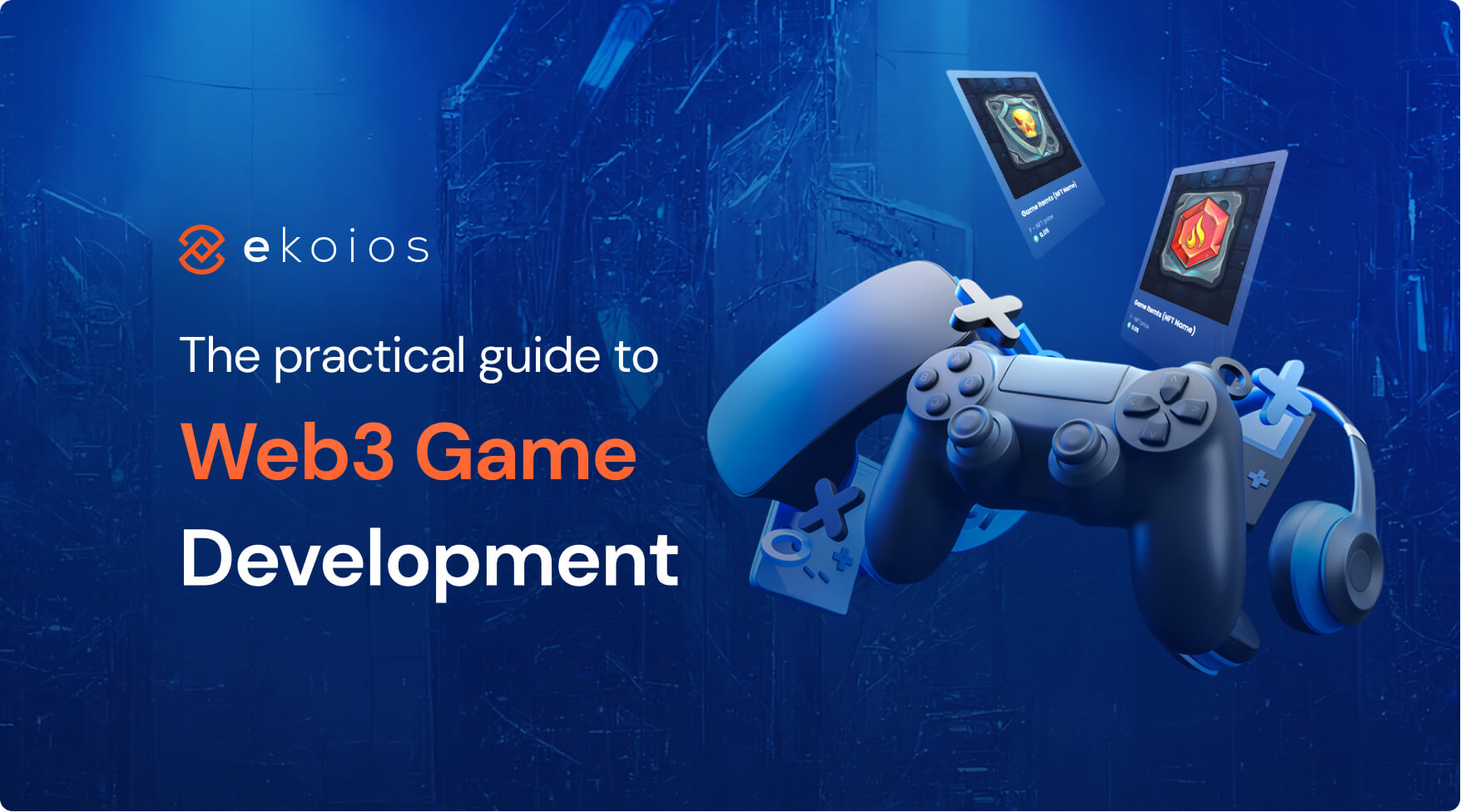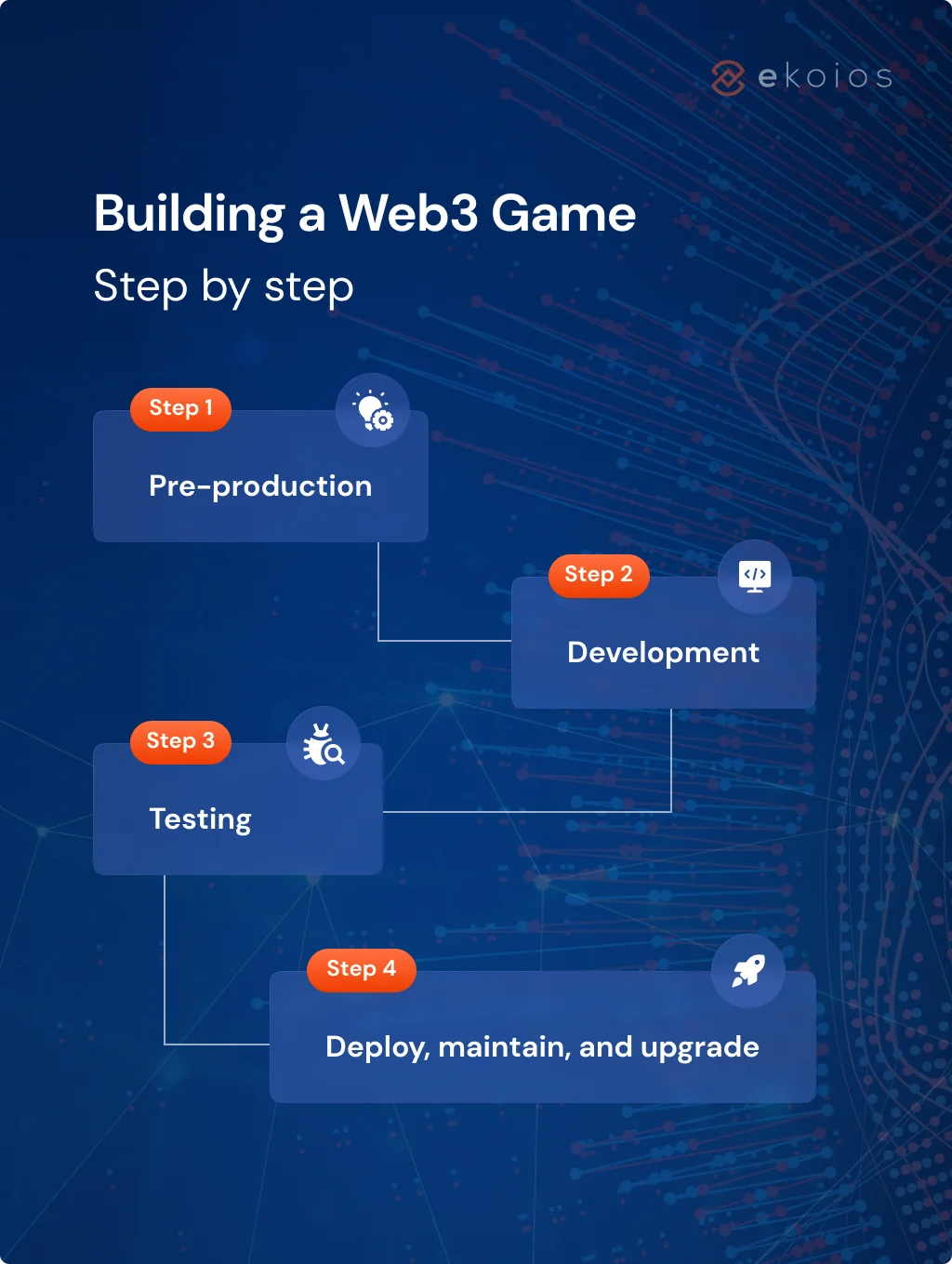
- 1
- 2
- 3
- 4
- 5
- 6
Web3 games are changing the gaming industry. Pioneered by Axie Infinity, the gaming industry is on the brink of a revolution — set in motion by blockchain technology. New revenue streams are emerging as a result, with a promise to democratize in-game ownership through native tokens, including NFTs. While this is an exciting paradigm shift, experts and players alike are cautious given that the Web3 gaming guide is by definition prone to risk.
From this article, you’ll learn how to approach the development of your next web3 game and boost your business performance by creating games that captivate your attention.
Web3 Gaming Explained
1. What is Web3 Gaming?
Web3 games allow players to obtain real-world value by using in-game items and other digital goods such as non-fungible tokens and cryptocurrencies. A new paradigm has been introduced by the advent of NFT technology – a gaming ecosystem where players can own their assets, which can be traded and sold later on for real value.
2. Key Characteristics of Web3 Gaming
The new game model in web3 games gives players greater privileges in terms of ownership, control, and flexibility to trade in-game assets and collectibles. Here are some of the basic features found in modern web3 games:
- Ownership Control and Seamless Asset Transfer: Web3 ensures users have true ownership of their in-game assets while offering the advantage of competitive asset interoperability. For example, in one game, players own in-game assets and use them on another platform of their choice.
- Player-Centric Experiences: Top players in Web3 games show how the new gaming ecosystem thrives on experiences tailored to player preferences.
- Transparency and Availability: One of the most prominent highlights of Web3 games relates to the distributed nature of processes. Additionally, blockchain-based games use voting consensus to modify the game process.
Tap into a growing market
1. Market size
The Web3 games industry is still in its early stages of development, leaving plenty of room for exploration and growth. While the traditional gaming market has reached maturity and is projected to grow by just 10.0 CAGR (Accenture), Web3 games are up ten times. At a CAGR of 100%, the market is expected to grow from $1.5 billion in 2021 to $50 billion in 2025, involving 1 million to 10 million players per day (Bitkraft Ventures & Naavik and Dizon).
This visionary growth allows for new Web3 game projects as well as the migration of large-scale traditional games into the blockchain space. Companies such as Atari ($72 million market cap) and WeMade ($640 million market cap) have issued their own crypto tokens called ATRI and WEMIX, respectively, and Bandai has a $130 million investment to build a Gundam-themed metaverse. Even Apple, which used to ban NFTs entirely, now allows in-app purchases.
2. Revenue opportunities
Web3 games allow players to own assets, but there are still many ways for game developers to make money.
Entry capital
Most Web3 games (e.g. Axie Infinity, Alien Worlds, Sorare) require an upfront investment to enter the game, which is relatively small ($5 to $20) but remains a consistent revenue stream. A few are free to enter (e.g. Splinterlands, Gods Unchained, Thetan Arena) but feature premium and exclusive items for purchase.
Native tokens
You can issue native tokens used for in-game transactions and are equivalent to real money. Frequently, a token designated solely for DAOs or governance is also available.
NFT
Compared to tokens, NFT is much rarer because of its non-fungibility. NFTs can be traded freely on in-game NFT marketplaces, with you gaining a small percentage as a transaction fee. NFTs come in a variety of shapes depending on the ecosystem, including:
- Gamers’ avatars
- Cards and collectibles
- Virtual property (land, planets)
- Land ownership
- Equipment and accessories (weapons, skins, etc)
Traditional revenue streams
Advertising and collaborations with other games or blockchain projects.
🔸 Interested in web3 trends in 2023? Read this article
Building a Web3 Game: 5 Factors to consider
1. Gameplay
In stage one, you must decide on your idea based on genres. It would be mandatory to examine use cases and choose games in which NFTs make sense. The following types of games could be transformed into non-fungible tokens:
- Action games
- Arcade games
- Adventure games
- Casino games
- Card games
- Racing games
- Online board games & more!
2. Technology requirements
According to Footprint Analytics, the most popular chains for Web3 games are Wax, BNB, Polygon, Ronin and Hive. In terms of languages and software, you can utilize Unity3d, C#, ASP.NET Core, MongoDB, MySql, Truffle, and AWS. Also, make sure your game can be launched on multiple devices with different operating systems, such as web, PC, Android, and iOS.
Below are the key elements of Web3 games:
- Web3 dApps: the tools needed to support in-game assets and transactions.
- Smart Contracts: helps define voting and decision-making rules for changes needed to develop a game.
- Node Providers: for extracting game information on the blockchain network.
- Media Standards: Web3 games require open and interoperable media design standards to handle text, audio, video, 3D scenes, and many other vectors for dApp support.
- Digital Wallet: is used to identify and store various in-game assets and collectibles
- XR Hardware: haptic gloves, smart glasses, scanning sensors, etc. for enhancing Web3 gaming experiences
3. NFT Applications
NFTs can be used to provide a variety of functions.
🔎 For example, they can be used to facilitate ownership and possession by players—some items within a game world may be unique collectibles that can only be collected and owned by one party. Players who want to express their connection to a specific object can purchase valuable NFTs within the game environment or gain some through play. Users who wish to trade NFTs with other users can do so right within the game environment and help them advance in the game or gain an advantage over opponents.
Additionally, an NFT’s value could serve as a collector’s item within a game—this would help reinforce certain aspects of psychological storytelling for players who don’t want or need more sophisticated narratives.
4. Sustainability
There are many barriers to entry into the Web3 game, including obtaining crypto, creating a wallet, and paying gas fees. Not to mention the general information asymmetry about blockchains. This doesn’t mean that “free to play” is always the way to go, but the higher the player entry fee, the harder it is to democratize Web3 games. Expensive buy-ins should be justified.
Web3 Game sustainability is based on:
- Accessibility and attractiveness: How you can make the game easy to enter while engaging to play will determine how quickly the game can grow its player base.
- A handy utility for in-game assets inside and outside the game.
- Solid partnerships with multiple revenue streams make the project more stable and act as a safety net should one of the streams fail.
📌 Read more about Sustainable Web3 Gaming
5. Community
Community is a key pillar in gaming as it helps players share experiences and form relationships, subsequently staying more connected to the game.
Telegram, Discord, and Twitter have emerged as epicenters of Web3 life; other social media channels like TikTok, Instagram, and Twitch remain telling of the project’s connection with the community. DAOs will play a pivotal role in fulfilling the web3 promise of a truly decentralized, thriving community—which is why those doing it must get it right.
Sandbox: a case study of web3 game
The Sandbox is a user-generated gaming platform where players can build, own, and monetize virtual assets on the Ethereum blockchain. It features three main components: VoxEdit (a creative editor to design NFTs), NFT Marketplace (where players trade NFTs among themselves), and Game Maker (which allows any player to make their own 3D games).
As of January 2022, The Sandbox reported having 18,000 land owners on its platform, with 1.6 million users that have connected their wallets, which represents a 1000% growth compared to the previous year! These impressive metrics make perfect sense given the solid foundation on which the game is built.
Here are the factors that make The Sandbox sustainable:
- An instantly recognizable visual universe that appeals to large audiences.
- Customizable gameplay that unlocks user creativity and encourages engagement.
- Free-to-play model, widely accessible
- Unique tokenomics for native tokens that sustain the ecosystem.
- A growing network of partnerships with leading IPs and brands (Snoop Dogg, deadmau5, Warner Music, Gucci, Ubisoft, etc.)
- A comprehensive roadmap detailing various past milestones (downloads, partnerships, events, etc.) and quarterly future projections.
- A large and vibrant community on Twitter (851,000 followers) and Discord (280,000+ followers).
- A Game Maker Fund to incentivize user projects.
- A sandbox DAO that allows players to participate in important decisions on the gaming platform.

Building a Web3 Game: Step by step
Depending on the type of project, its core gameplay, and the implementation of specific features, the process of developing an NFT gaming platform can be extended with additional steps. However, we’ve listed the four essential steps below.
Step 1: Pre-production
- Recruit experts for your team / pick a top Web3 development companies
- Gather market data
- Define the platform, tech stack, and game concept.
- Make a design document for the game (GDD)
- Create a prototype for your game’s demo
Step 2: Development
- Art design
- Level design
- Crypto wallet setup
- Smart contract development
- Game development
Step 3: Testing
To make sure a game is free of bugs, testing should receive extra attention. Unit, alpha, and beta testing are the three main QA (quality assurance) stages that guarantee a thorough examination.
Functional game testing
- Interoperability
- Regression
- Smoke
- Localization
- Security access control
- User Acceptance
Non-functional game testing
- Performance
- Load & stress
- Stability
- Usability
- Compliance
- Configuration
Step 4: Deploy, maintain, and upgrade
When your tester team gives the go signal, it’s time to deploy the game and welcome players!
However, the work doesn’t end as any game requires constant tracking, analysis, and improvement. 
Kick off your Web3 game with Ekotek Technology
Even without the expertise, anyone does have a chance to create iconic Web3 games. We hope this article has given you some important insight into the main types of Web3 games, their main features and factors, and the stages of Web3 game development.
At Ekotek Technology, we understand that launching a Web3 game from scratch requires a huge investment of time, effort, and resources. We have introduced winning strategies to well-known Web3 games such as Monsterra and Age of Gods with a team of both blockchain and gaming specialists, offering full-cycle game development services, from art & game design to blockchain integration and ecosystem infrastructure.
So if you’re looking for a reliable tech partner or a strategic consultant for the next great Web3 game, contact Ekotek today – we’re glad to be of service!
- 1
- 2
- 3
- 4
- 5
- 6
